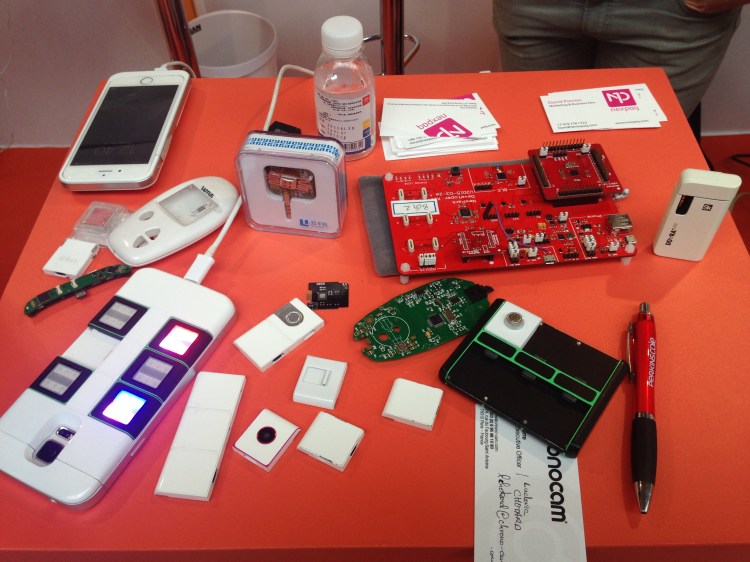The latest example of how a small startup can build disruptive hardware to challenge a goliath comes courtesy of the team behind Nexpaq, a modular smartphone case.
The idea behind Nexpaq is to create a basic skeleton that clips to the back of an iPhone 6 or Samsung Galaxy S6 or S5 and that has six slots for modules that can be swapped in and out. It’s a concept that closely mirrors Google’s Project Ara, an attempt to build a modular smartphone that people assemble by choosing each component.
This week I met some of the team from Nexpaq at the Connected Conference in Paris, and I’m convinced that their approach is both smarter and more practical than Google’s.
And in any case, the fact that this virtual company thinks it can compete with Google shows just how the economics and business of hardware have radically changed. The proliferation of 3D printing, crowdfunding, and smartphones have planted the seeds for a frenzy of hardware innovation and development.
In fairness, the two projects have slightly different aims. Nexpaq’s founders believe there is an opportunity to radically extend and personalize the features and functions of a phone. The cost for the product is roughly $89, plus you have to buy the phone and assorted modules.
According to Google, Project Ara has a social mission, with a goal of creating a phone for the “next 5 billion people.” In this case, Google wants to do it by creating a system that lets you build your entire phone from scratch by selecting modular components that snap together (for the battery, the camera, the processor, etc.).
Reports have said Google is trying to ship Project Ara for $50 or less, but the company acknowledges the cost of the basic endoskeleton and components could be up to $100.
“It’s important to note that this is just the cost of the components and says nothing about how it will be priced — it could be more or less than that (e.g., with a carrier contract),” Google says. “In the end, we expect that module developers will be able to set the prices for their modules sold in the Ara Module Marketplace, much like mobile app developers do in app stores today.”
Project Ara is being developed by Google’s Advanced Technology and Projects (ATAP) group, which presumably has unlimited resources to meet its goals.
By comparison, Nexpaq, officially based in Los Angeles, has been under development for two years by a team of under 10 people who are scattered around the globe in Moscow, London, and Shenzhen. The company has blown past its Kickstarter goal of $50,000 to raise $269,336.
Now, Nexpaq is preparing to go into production, with backers scheduled to receive their first units in November 2015. Currently, the company has developed 12 modules, including a USB module, extra battery, breathalyzer, amplified speaker, flash drive, air quality gauge, laser pointer, LED flashlight, and thermometer.
Google, meanwhile, says it might have a pilot project in Puerto Rico some time this year, but the timetable for releasing the actual product remains unclear. Google has held developers’ conferences for Project Ara, but people thinking about building for the platform can’t be sure if or when Ara might be in consumers’ hands.
That is giving Nexpaq an opening to start building its ecosystem of developers. The company is holding a Hardware Hackathon in Melbourne, Australia this summer, where 10 projects will be chosen to receive additional development assistance.
Google’s modular approach is potentially intriguing, but conceptually, it seems complex to ask average consumers, especially those who need cheap smartphones, to evaluate and select among the various specs for the entire phone. Such choices can be puzzling in the best of circumstances, like when your parents are buying a Dell PC online, or even just trying to figure out how much memory they want for their new iPhone.
In terms of cheap smartphones, there are already a number of low-cost Android devices on the market around the globe, and Microsoft is pushing hard in this direction to reboot its Windows Phones efforts. It’s not clear whether the lack of an affordable smartphone, or the ability to personalize it, is really the barrier to convincing the next 5 billion people to get one.
With Nexpaq, users will already have their smartphone, and attaching the skeleton and adding something like an extra battery seems far more straightforward. And with the product ready to hit the market this year, that would seem to be more attractive to developers who are thinking about where to put their attention and resources.
Of course, Google has limitless resources and can develop its Project Ara as long as it wants, with failure hardly causing a ripple to its overall business. It’s certainly one of those ideas that’s good for creating the kind of geeky buzz Google loves.
But in terms of actually building a product that may change the way we use our smartphones, the edge for the moment goes Nexpaq.


